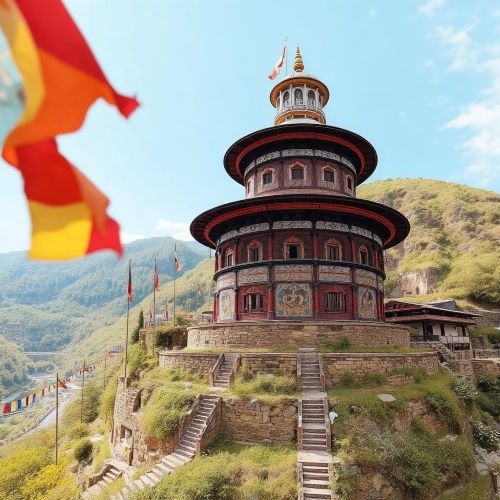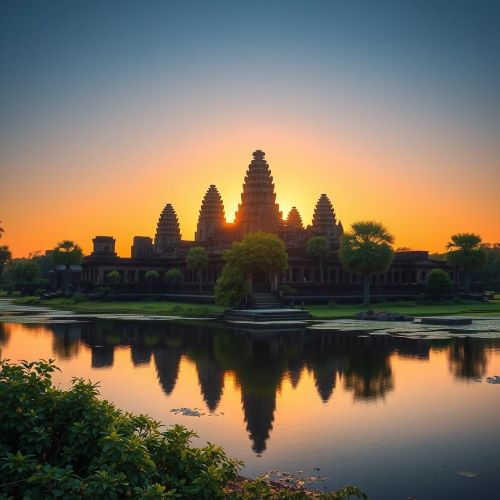Tikal : The Towering Temple
At a glance
| Description | |
|---|---|
| Mythology | Mayan Mythology |
| Country | Guatemala |
| Closest airport | Mundo Maya International Airport (FRS) |
| Type | Constructed |
| Accessibility | 09/10 |
Introduction
Hidden in the dense rainforests of northern Guatemala, Tikal rises as one of the most remarkable achievements of the ancient Maya civilization. Once a thriving metropolis and spiritual hub, the city is now a breathtaking archaeological site where history, myth, and nature converge. Its soaring pyramids pierce the jungle canopy, while echoes of ritual chants linger in the air, giving visitors a sense that Tikal is more than stone ruins—it is a living connection to a civilization that mastered astronomy, architecture, and kingship. Today, Tikal stands as both a UNESCO World Heritage Site and one of the most captivating destinations in Central America.
Connection with Mythology
Tikal, known in ancient times as Yax Mutal, was deeply intertwined with Mayan cosmology. The Maya viewed their rulers as divine mediators, descended from celestial beings, and the temples of Tikal reflect this belief through their alignment with solstices, equinoxes, and planetary cycles.
According to the Popol Vuh, the sacred text of the K’iche’ Maya, the gods shaped the world through trials of darkness and rebirth, a story symbolically embedded in Tikal’s architecture. The Hero Twins, who triumphed over the lords of the underworld, represent the eternal struggle of life and death, echoed in the funerary pyramids like Temple I, built as the resting place of King Jasaw Chan K’awiil I.
Deities such as Itzamná, the god of creation, Chac, the rain bringer, and Yumil Kaxob, the maize god, were central to rituals at Tikal. Blood offerings, feasts, and astronomical observations honored these powers, ensuring prosperity for the city. Even the name “Tikal,” meaning “place of voices” or “at the waterhole,” suggests a spiritual resonance, as if the city itself were alive with divine whispers.
Ways to Get There
Reaching Tikal may feel like an adventure in itself, but it is relatively straightforward thanks to modern infrastructure. The gateway town is Flores, situated about 65 kilometers from the site.
The quickest option is to fly from Guatemala City to Flores’ Mundo Maya International Airport, a journey of just one hour. From there, shuttles, taxis, and organized tours make the 90-minute drive to Tikal’s entrance. Travelers from Belize often arrive through San Ignacio, with day tours that cross the border directly into the park.
For those seeking a slower pace, overnight buses from Guatemala City to Flores take eight to ten hours, followed by a shuttle transfer. Adventurous visitors sometimes rent cars, but road conditions require patience and caution. To fully appreciate the site, many choose to stay overnight either inside the national park or in Flores, allowing time for sunrise and sunset tours that reveal the ruins in their most mystical light.
What to Look For
With more than 3,000 mapped structures spread across 16 square kilometers, Tikal is vast, and even a full day only scratches the surface. Still, certain highlights are unmissable.
At the heart of the site lies the Gran Plaza, flanked by Temple I and Temple II, the city’s iconic pyramids. Temple I, the Temple of the Great Jaguar, rises 47 meters and housed the tomb of King Jasaw Chan K’awiil I, while Temple II was built for his queen, Lady Kalajuun Une’ Mo’. The North Acropolis, a sacred burial site, and the Central Acropolis, once filled with palaces, frame the plaza with grandeur.
The tallest structure, Temple IV, towers 70 meters above the jungle canopy, offering sweeping views of the surrounding rainforest. It became globally famous after appearing in Star Wars: A New Hope. Other landmarks include the Mundo Perdido (Lost World) complex, home to the city’s oldest pyramid, and Temple V, with its steep, moss-covered steps.
Beyond architecture, Tikal is a haven for wildlife. Howler monkeys roar from treetops, colorful toucans dart through the branches, and coatis scavenge near pathways. Lucky visitors might glimpse elusive jaguars or pumas, though most encounters are with playful spider monkeys and flocks of macaws. This blend of archaeology and ecology makes Tikal a destination like no other.
Importance in cultural history
Tikal’s history stretches back nearly 3,000 years, with evidence of settlement as early as 900 BCE. By the Classic Period (250–900 CE), it had become one of the most influential city-states in the Maya world, controlling trade routes and forging alliances across Mesoamerica. Its population may have reached 90,000 at its peak, making it a bustling metropolis surrounded by farmland and satellite villages.
The city’s fortunes shifted dramatically over time. In 378 CE, emissaries from Teotihuacan reshaped its dynasty, ushering in new cultural influences. In 562 CE, rival city Calakmul defeated Tikal, leading to more than a century of decline. Yet under rulers like Jasaw Chan K’awiil I in the late 7th century, Tikal experienced a resurgence, marked by monumental construction and renewed political dominance.
By the late 9th century, however, prolonged drought, overpopulation, and possible epidemics led to Tikal’s abandonment. For centuries, the rainforest consumed its pyramids until explorers in 1848 rediscovered its ruins. Archaeological excavations in the 20th century revealed the scale of the metropolis, though only a fraction has been uncovered. Recognized as a UNESCO World Heritage Site in 1979, Tikal is both a cultural treasure and a natural sanctuary, preserving the intertwined legacy of human ingenuity and ecological richness.
Best time to travel
The best season to visit Tikal is the dry season from November to April, when weather is more predictable, skies are clear, and humidity is lower. This period is ideal for photography and long hikes through the site’s expansive trails. November to February offers cooler temperatures, while March and April can be warmer but still manageable.
The rainy season, from May to October, brings lush landscapes and fewer visitors, appealing to those who enjoy solitude and don’t mind sudden tropical showers. Trails can become muddy, but the vibrant greenery and wildlife activity provide a unique charm.
For a magical experience, sunrise and sunset tours are highly recommended. At dawn, Temple IV offers sweeping views of mist rising from the jungle as howler monkeys announce the day. Sunsets, often clearer than mornings, bathe the pyramids in golden light, providing unforgettable vistas.
Source
Clemente, M. (2025, April 22). Tikal: The myths and legends that define its origins. Mayan Mythology Worldwide. https://mayan.mythologyworldwide.com/tikal-the-myths-and-legends-that-define-its-origins/
Rosado van der Gracht, C. (2025, April 8). Ancient Teotihuacan altar found in Tikal reveals Maya connection. Yucatán Magazine. https://yucatanmagazine.com/teotihuacan-altar-tikal/
World History Edu. (2025, January 8). Ancient city of Tikal: History and major facts. https://worldhistoryedu.com/ancient-city-of-tikal-history-and-major-facts/
Cartwright, M. (2014, October 8). Tikal. World History Encyclopedia. https://www.worldhistory.org/Tikal/
Trailwalker Travels. (2025). Tikal Guatemala: Best tips for visiting the Mayan ruins. https://trailwalkertravels.com/tikal-guatemala-travel-guide/
Im Jess Traveling. (2025). How to get to Tikal in Guatemala. https://imjesstraveling.com/how-to-get-to-tikal/
Expertravell. (2025). How to get to Tikal: Ultimate travel guide. https://expertravell.com/how-to-get-to-tikal/
Go Guatemala Travel. (2025). Ultimate guide to visit Tikal in Guatemala by an expat. https://goguatemalatravel.com/visiting-tikal-guatemala/
Road Affair. (2023). The ultimate guide to visiting Tikal in Guatemala. https://www.roadaffair.com/visiting-tikal-guide/
Frequently Asked Questions
Lorem ipsum dolor sit amet, consectetur adipiscing?
Lorem ipsum dolor sit amet, consectetur adipiscing elit. Praesent convallis vestibulum justo, ac tincidunt nunc vehicula quis. Nullam id dolor quis orci malesuada feugiat. Curabitur aliquet libero at urna ullamcorper, ac ultricies nulla dapibus.
Lorem ipsum dolor sit amet, consectetur adipiscing?
Lorem ipsum dolor sit amet, consectetur adipiscing elit. Praesent convallis vestibulum justo, ac tincidunt nunc vehicula quis. Nullam id dolor quis orci malesuada feugiat. Curabitur aliquet libero at urna ullamcorper, ac ultricies nulla dapibus.
Lorem ipsum dolor sit amet, consectetur adipiscing?
Lorem ipsum dolor sit amet, consectetur adipiscing elit. Praesent convallis vestibulum justo, ac tincidunt nunc vehicula quis. Nullam id dolor quis orci malesuada feugiat. Curabitur aliquet libero at urna ullamcorper, ac ultricies nulla dapibus.
Lorem ipsum dolor sit amet, consectetur adipiscing?
Lorem ipsum dolor sit amet, consectetur adipiscing elit. Praesent convallis vestibulum justo, ac tincidunt nunc vehicula quis. Nullam id dolor quis orci malesuada feugiat. Curabitur aliquet libero at urna ullamcorper, ac ultricies nulla dapibus.
Lorem ipsum dolor sit amet, consectetur adipiscing?
Lorem ipsum dolor sit amet, consectetur adipiscing elit. Praesent convallis vestibulum justo, ac tincidunt nunc vehicula quis. Nullam id dolor quis orci malesuada feugiat. Curabitur aliquet libero at urna ullamcorper, ac ultricies nulla dapibus.









